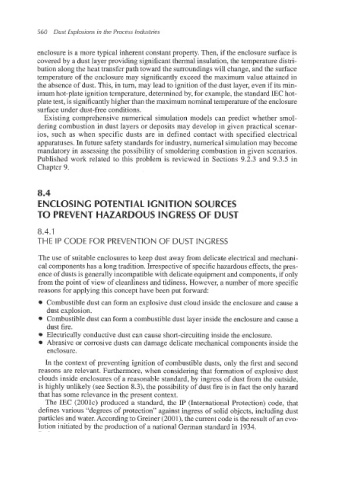Page 593 - Dust Explosions in the Process Industries
P. 593
560 Dust Explosions in the Process Industries
enclosure is a more typical inherent constant property. Then, if the enclosure surface is
covered by a dust layer providing significant thermal insulation, the temperature distri-
bution along the heat transfer path toward the surroundingswill change, and the surface
temperature of the enclosure may significantly exceed the maximum value attained in
the absence of dust. This, in turn, may lead to ignition of the dust layer, even if its min-
imum hot-plate ignition temperature,determinedby, for example, the standard IEC hot-
plate test, is significantlyhigher than the maximum nominal temperature of the enclosure
surface under dust-free conditions.
Existing comprehensive numerical simulation models can predict whether smol-
dering combustion in dust layers or deposits may develop in given practical scenar-
ios, such as when specific dusts are in defined contact with specified electrical
apparatuses. In future safety standards for industry, numerical simulation may become
mandatory in assessing the possibility of smoldering combustion in given scenarios.
Published work related to this problem is reviewed in Sections 9.2.3 and 9.3.5 in
Chapter 9.
8.4
ENCLOSING POTENTIAL IGNITION SOURCES
TO PREVENT HAZARDOUS INGRESS OF DUST
8.4.1
THE IP CODE FOR PREVENTION OF DUST INGRESS
The use of suitable enclosures to keep dust away from delicate electrical and mechani-
cal components has a long tradition. Irrespective of specific hazardous effects, the pres-
ence of dusts is generally incompatiblewith delicate equipmentand components,if only
from the point of view of cleanliness and tidiness. However, a number of more specific
reasons for applying this concept have been put forward:
Combustible dust can form an explosive dust cloud inside the enclosure and cause a
dust explosion.
Combustible dust can form a combustible dust layer inside the enclosure and cause a
dust fire.
Electrically conductive dust can cause short-circuitinginside the enclosure.
Abrasive or corrosive dusts can damage delicate mechanical components inside the
enclosure.
In the context of preventing ignition of combustible dusts, only the first and second
reasons are relevant. Furthermore, when considering that formation of explosive dust
clouds inside enclosures of a reasonable standard, by ingress of dust from the outside,
is highly unlikely (see Section 8.3), the possibility of dust fire is in fact the only hazard
that has some relevance in the present context.
The IEC (2001~)produced a standard, the IP (International Protection) code, that
defines various “degrees of protection” against ingress of solid objects, including dust
particles and water. According to Greiner (2001), the current code is the result of an evo-
lution initiated by the production of a national German standard in 1934.

